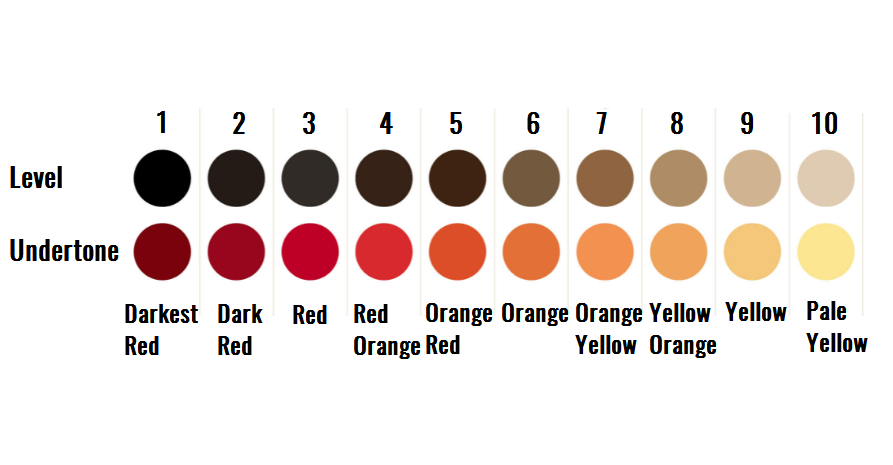Hair Level Chart - How to Know Your Hair Color Levels for the Best Dye
To achieve a perfect dyeing result, you need to accurately describe the depth of the hair color, as well as the lightness or darkness of the hair. Here, we’ll explain each number in the hair color levels 1-10 chart with tones, how to know your hair level, and pick the best dye color.
What Are Hair Levels and Tones?
Hair color is composed of two parts: level and tone. Hair level refers to the lightness or darkness of the color and the amount of black and brown pigment you have. There is a numbering system that includes 10 digits, each of which represents a unique depth of hair color, ranging from Level 1 to Level 10. Level 1 means the darkest color, while Level 10 means the lightest color. Generally, you can only achieve two shades lighter or darker than your current hair color without bleaching. A hair color level chart is a visual guide that helps you avoid confusion when choosing a color, allowing you to accurately tell your stylist what shades you want.
Tone is the base color of the hair, determined by the amount of red and yellow pigment in the hair. Tones work with those levels to give you the exact color you want. For example, if you have dark hair (level 1 or 2) and you want a warm look, you might go for a dark brown with a red or gold tone. If you have light hair (level 7 or higher) and you want a really cool look, you might go for an ash blonde. When we bleach hair, it's like uncovering hidden colors beneath the surface. Imagine your hair is like a layered cake, and as we lift the top layers with bleach, we reveal different colors underneath. These hidden colors are called undertones. For example, if you start with very dark hair, like black or dark brown, bleaching might first reveal red or reddish-brown tones. As you keep bleaching, you might see orange or even yellow tones. These undertones are natural colors that appear when the hair's original pigment is removed.
Hair Color Levels 1-10 Chart with Undertones
| Level | Hair Color |
|---|---|
| 1 | Black |
| 2 | Darkest Brown |
| 3 | Dark Brown |
| 4 | Medium Brown |
| 5 | Light Brown |
| 6 | Dark Blonde |
| 7 | Medium Blonde |
| 8 | Blonde |
| 9 | Light Blonde |
| 10 | Lightest Blonde |
Hair Colour Levels Expained
Level 1 Hair: Black
This is the darkest hair color, pure black with no brown tones. It’s very deep and rich. Because it’s so dark, it’s hard to lighten without bleaching, and semi-permanent colors usually don’t show up well on this level.
Level 2 Hair: Darkest Brown
This shade is almost black but has some dark brown undertones. It looks like very dark coffee and is still very deep, but has a little bit of warmth or color beneath the surface.
Level 3 Hair: Dark Brown
A shade lighter than level 2, this color resembles dark chocolate. It’s clearly brown but still quite dark, so it can take some work to lighten it for brighter or bolder colors.
Level 4 Hair: Medium Brown
This is a classic brown color, neither too dark nor too light. It’s often called “true brown” and looks like rich chocolate. It needs to be lightened if you want bright or unnatural hair colors.
Level 5 Hair: Light Brown
This shade is lighter than medium brown and can sometimes look like warm dark blonde or even have some red tones. It’s an easy base for many hair colors and can be darkened or lightened with less effort.
Level 6 Hair: Dark Blonde
The first level in the blonde range, dark blonde, can look like dirty blonde, honey blonde, or even a darker strawberry blonde. It’s a natural-looking blonde shade that still has some warmth.
Level 7 Hair: Medium Blonde
A bright blonde who looks more yellow or golden. It’s lighter than dark blonde and is often what people imagine when they think of blonde hair.
Level 8 Hair: Blonde
This is a pale yellow blonde, lighter than medium blonde but still with a hint of warmth. It’s a great base for most bright or pastel hair colors without needing intense bleaching.
Level 9 Hair: Light Blonde
Almost platinum, this shade is very light but not completely white. It can show off bright or vivid colors well, but may have some yellow undertones that colorists often neutralize.
Level 10 Hair: Lightest Blonde
The lightest natural hair color, this almost white or platinum blonde shade has almost no yellow tones. It’s perfect for pastel colors and the brightest hair dyes, showing true vibrancy.
Level 6 vs Level 7 Hair
Level 6 and Level 7 hair colors are both in the blonde hair levels, but have some important differences in shade and tone. Level 6 is considered dark blonde and often looks like a rich, warm honey or dirty blonde with hints of golden or strawberry tones. It’s a deeper, more natural blonde that still has some brown mixed in, making it a great choice for people who want a subtle, sun-kissed look without going too light. On the other hand, Level 7 is a medium blonde, brighter and lighter than Level 6, with more yellow or golden hues that make the hair look sunnier and more vibrant. This shade is closer to what most people think of as classic blonde. Because Level 7 is lighter, it can show brighter colors better, but might also reveal more warmth or brassiness that sometimes needs toning.
How to Know Your Hair Level?
1. The Natural Light Test
Stand in a place with plenty of natural sunlight, either near a window or outside. Take a small section of your hair and hold it away from your head so light can shine through it. This helps you see the true shade — whether it’s dark or light — more clearly. Using a mirror can help, but remember that indoor lighting or magnification might change how your hair looks. Natural light is the best way to see your hair color.
2. Compare to a Hair Level Chart
This method is one of the easiest. Find a hair level chart online — it’s a picture that shows hair shades numbered from 1 (black) to 10 (lightest blonde). Hold a piece of your hair next to the chart to find the closest match. Because hair can have different shades, especially if you have highlights or gray hair, check several sections to get the most accurate idea of your overall hair level.
3. The Black-and-White Photo Trick
If you have trouble matching your hair to the color chart, try this clever hack. Take a photo of your hair and change the image to black and white (grayscale). Do the same with a hair level chart image. When you put the two black-and-white pictures side by side, it’s easier to compare the darkness or lightness without being distracted by the color tone. This trick works great if your hair color is unusual, like red or bright fantasy colors.
Steps to Find Your Hair Level at Home
Pick a strand from the crown or the back of your head, because hair here shows your true natural color best. Hold this section away from your scalp and the rest of your hair so light can pass through it.
Go into sunlight or near a window with bright daylight. This natural lighting will show you the real shade better than artificial light indoors.
If it’s hard to see, use a handheld mirror to look closely at the hair section. Or take a clear photo of the section in natural light, so you can compare it more carefully later.
Look at the above hair level chart. Match your hair section to the closest shade on the chart. Remember, the level number tells you how dark or light your hair is, not the exact color tone.
Hair can have many shades, especially if you have highlights, gray hair, or dyed parts. Check a few different spots on your head to get a full picture.
Once you know your current hair level, you can plan your next hair color steps. Keep in mind, permanent dyes usually lighten only 1–2 levels, and going darker is easier but should be done gradually to keep hair healthy.
How to Choose the Right Color of Hair Dye?
What is the best hair dye color? The two most important factors to consider are your hair level and your hair tone.
1. Know Your Hair Level
Before buying any hair dye, find out your current hair level. You can check this by looking at your hair in natural sunlight and comparing it to the hair level chart. Knowing your level helps you understand which colors will work best and how much you can safely lighten or darken your hair.
2. Understand Your Hair Tone (Undertones)
Hair tone refers to the warmth or coolness of your hair color, which comes from natural pigments beneath the surface. When choosing a dye, it’s important to pick a shade that complements your natural undertones or that can neutralize unwanted brassiness. For example, if your hair has warm yellow tones and you want a cooler blonde, your stylist may use a toner with violet or blue shades to balance it out.
3. Match Hair Color with Skin Tone
To make your new hair color look natural and flattering, think about your skin tone. Warm hair colors like golden blonde or copper red usually look great with warm skin tones (peachy or golden undertones). Cool hair shades, such as ash blonde or cool brown, tend to suit cooler skin tones (pink or blue undertones).
4. Consider How Much You Want to Change
If you want to go lighter, remember that most hair dyes can lift your natural color by only 1 or 2 levels without bleach. For example, if you have level 4 (medium brown) hair, you can safely lighten it to level 5 or 6 with regular dye. Going much lighter usually needs bleaching, which can damage hair if not done carefully. If you want to go darker, it’s easier and healthier to do it gradually, changing your shade one level at a time.
5. Think About Maintenance and Hair Health
Darker colors usually require less upkeep, while lighter or brighter shades may need more frequent touch-ups and special care to keep them looking fresh. Also, some colors need toners or special shampoos to keep unwanted tones away, like brassiness in blonde hair. Choose a dye and care routine that fits your lifestyle and hair health.
6. Ask a Professional if Unsure
If you’re unsure about picking the right shade or worried about how your hair will react, consulting a professional colorist is always a smart choice. They can analyze your hair’s level and tone, recommend the best shades, and guide you through any necessary lightening or toning steps to get the look you want safely.


